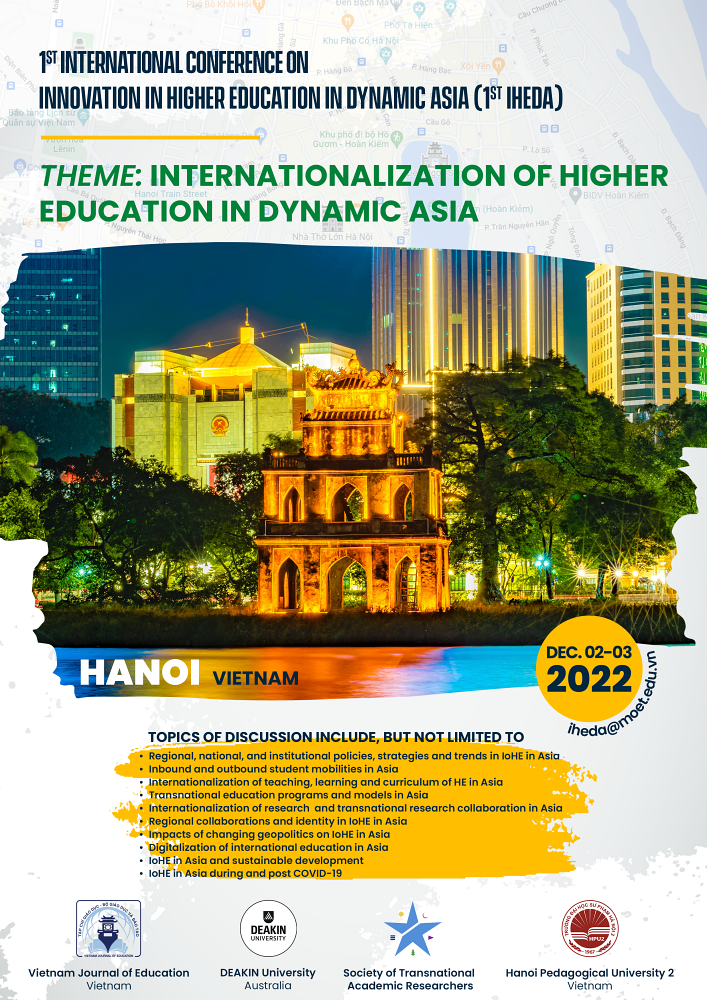Teacher’s and learner’s roles in autonomy-oriented foreign language teaching: a theoretical investigation
DOI:
https://doi.org/10.52296/vje.2020.17-
Downloads
How to Cite
Abstract
The global language teaching community has largely spotlighted students’ autonomous learning for the last few decades. Through the thorough review of the existing literature on learner autonomy, this article aims to theoretically investigate this concept as well as clearly specify the roles played by teachers and students in an autonomy-oriented classroom. Autonomous learning is not at all synonymous with the absolute elimination of teacher’s role and learner-learner relationships. In fact, language instructors need to comprehend their roles in a multidimensional way, and students are supposed to be responsibly active for their own learning process as well as positively interdependent for academic cooperation.
Downloads
References
Barman, B. (2013). Shifting education from teacher-centered to learner-centered paradigm. City University Journal, 1(1), 79-98.
Benson, P. (2012). Autonomy in language learning, learning and life. Synergies France, 9, 29-39.
Chan, V. (2000). Fostering learner autonomy in an ESL classroom. TESL Canada Journal, 18(1), 75-86.
Dang, T. T. (2010). Learner autonomy in EFL studies in Vietnam: A discussion from sociocultural perspective. English Language Teaching, 3(2), 3-9.
Dickinson, L. (1995). Autonomy and motivation: A literature review. System, 23(2), 165-174.
Egel, I. P. (2009). Learner autonomy in the language classroom: from teacher dependency to learner independency. Procedia - Social and Behavioral Sciences, 1, 2023-2026. doi:10.1016/j.sbspro.2009.01.355
Islam, M. N. (2011). Independent English learning through the Internet. Journal of Language Teaching and Research, 2(5), 1080-1085. doi:10.4304/jltr.2.5.1080-1085
Ivanovska, B. (2015). Learner autonomy in foreign language education and in cultural context. Procedia - Social and Behavioral Sciences, 180, 352-356. doi:10.1016/j.sbspro.2015.02.128
Kojima, H., & Kojima, Y. (2005). Teacher roles in learner-centered communicative EFL instruction. Bulletin of the Faculty of Education, Hirosaki University, 94, 59-72.
Kruk, M. (2012). Using online resources in the development of learner autonomy and English pronunciation: The case of individual learners. Journal of Second Language Teaching and Research, 1(2), 113-142.
Little, D. (1995). Learner as dialogue: The dependence of learner autonomy on teacher autonomy. System, 23(2), 175-181.
Little, D. (1996). Learner autonomy: Some steps in the evolution of theory and practice. The Irish Yearbook of Applied Linguistics, 16, 1-13.
Little, D. (2004). Democracy, discourse and learner autonomy in the foreign language classroom. Utbildning & Demokrati, 13(3), 105-126.
Littlewood, W. (1996). “Autonomy”: An anatomy and a framework. System, 24(4), 427-435.
Ma, Z., & Ma, R. (2012). Motivating Chinese students by fostering learner autonomy in language learning. Theory and Practice in Language Studies, 2(4), 838-842. doi:10.4304/tpls.2.4.838-842
Ming, T. S., & Alias, A. (2007). Investigating readiness for autonomy: A comparison of Malaysian ESL undergraduates of three public universities. Reflections on English Language Teaching, 6(1), 1-18.
Nguyen, N. T. (2012). “Let students take control!” - Fostering learner autonomy in language learning: An experiment. International Proceedings of Economics Development and Research, 30, 318-320.
Onozawa, C. (2010). Promoting autonomy in the language class - How autonomy can be applied in the language class. Retrieved from http://www.kyoai.ac.jp/college/ronshuu/no-10/onozawa1.pdf
Oxford, R. L. (1999). Relationships between second language learning strategies and language proficiency in the context of learner autonomy and self-regulation. Revista Canaria de Estudios Ingleses, 38, 109-126.
Phan, T. T. T. (2013). Developing autonomy in an East Asian classroom: from policy to practice. International Proceedings of Economics Development and Research, 68(2), 6-10. doi:10.7763/IPEDR.2013.V68.2
Ramos, R. C. (2006). Considerations on the role of teacher autonomy. Colombian Applied Linguistic Journal, 8, 183-202.
Ribbe, E., & Bezanilla, M. J. (2013). Scaffolding learner autonomy in online university courses. Digital Education Review, 24, 98-113.
Schreurs, J., & Dumbraveanu, R. (2014). A shift from teacher centered to learner centered approach. International Journal of Engineering Pedagogy, 4(3), 36-41. doi:10.3991/ijep.v4i3.3395
Talley, P. C. (2014). Students’ responses to learner autonomy in Taiwan: An investigation into learners’ beliefs. International Journal of Humanities and Social Sciences, 4(4), 24-34.
Yan, S. (2012). Teachers’ roles in autonomous learning. Journal of Sociological Research, 3(2), 557-562. doi: 10.5296/jsr.v3i2.2860
Yang, T. (2007). Changes in learner autonomy by means of journal writing: From the point of view of learners. Proceedings of the Independent Learning Association 2007 Japan Conference. Chiba: Kanda University of International Studies.
Zarei, A. A., & Zarei, N. (2015). On the effect of language proficiency on learners’ autonomy and motivation. Journal of English Language and Literature, 3(2), 263-270.
Zhuang, J. (2010). The changing role of teachers in the development of learner autonomy - Based on a survey of “English Dorm Activity”. Journal of Language Teaching and Research, 1(5), 591-595. doi: 10.4304/jltr.1.5.591-595.




















